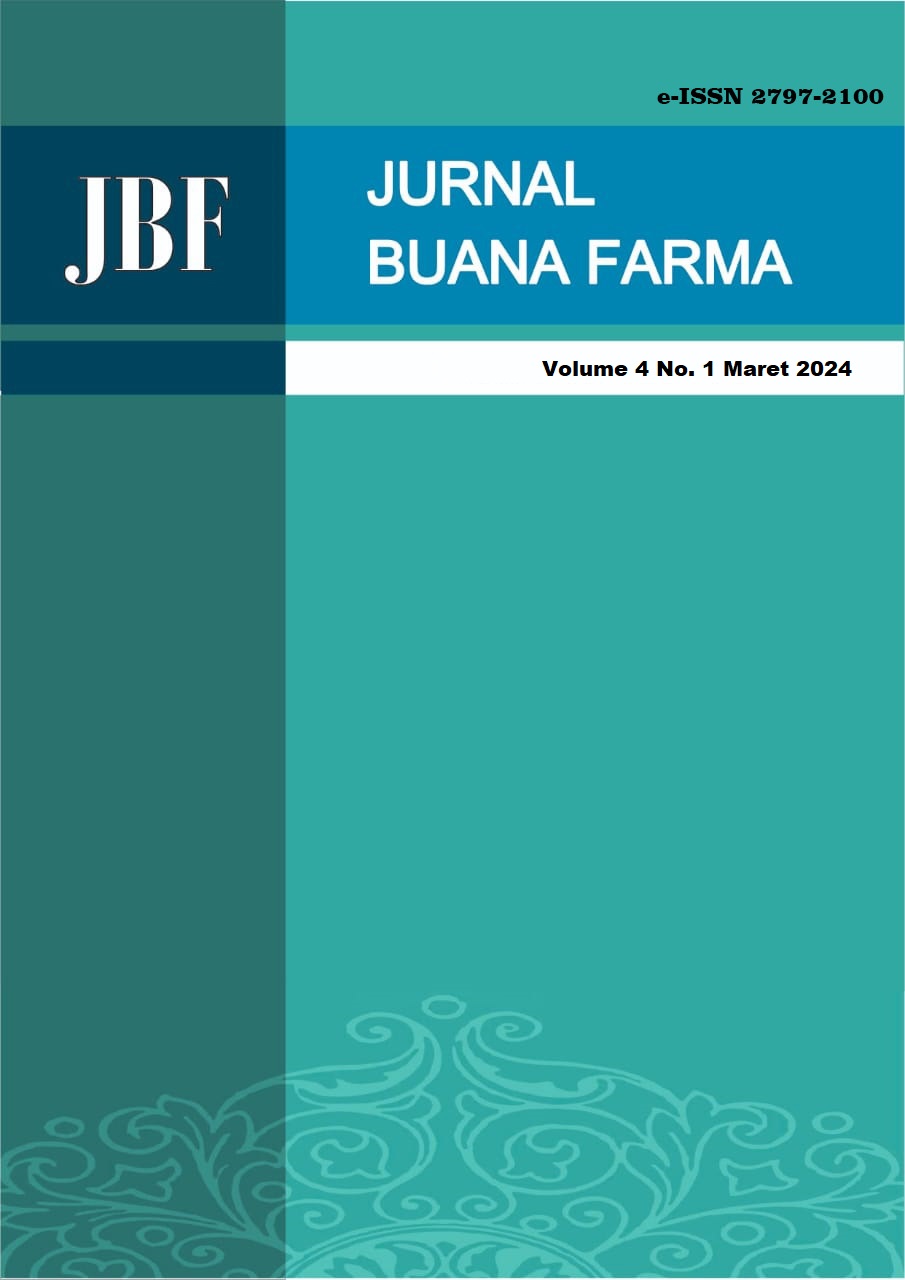PENGHAMBATAN ENZIM TIROSINASE dan AKTIVITAS ANTIOKSIDAN EKSTRAK BUNGA TELANG (Clitoria ternatea) MENGGUNAKAN METODE DPPH
Abstrak
Clitoria ternatea atau yang dikenal dengan nama bunga telang putih banyak dimanfaatkan dalam bidang kesehatan karena berbagai khasiatnya, antara lain sebagai antidiabetes, anti inflamasi, anti mikroba, antikanker, analgesik, antipiretik, dan antioksidan. Penelitian ini bertujuan mengkaji aktivitas antioksidan dan inhibitor tirosinase ekstrak etanol bunga telang putih serta mengidentifikasi kandungan fitokimianya. Aktivitas antioksidan ditentukan dengan metode DPPH. Hasil penelitian ini menunjukkan ekstrak bunga telang putih memiliki aktivitas antioksidan yang sangat lemah dengan nilai IC50 lebih dari 200 ppm. Hasil aktivitas inhibitor tirosinase menunjukkan bahwa ekstrak bunga telang putih tidak menghambat enzim tirosinase. Berdasarkan uji penapisan fitokimia, komponen kimia yang terkandung dalam ekstrak bunga telang putih adalah flavonoid, tanin, saponin, dan steroid. Ekstrak bunga telang putih memiliki aktivitas antioksidan yang sangat lemah dan pengujian inhibitor tirosinase menunjukkan ekstrak bunga antioksidan dengan metode DPPH. Hasil pengujian inhibitor tirosinase menunjukkan ekstrak Bungatelang putih tidak memiliki aktivitas menghambat enzim tyrosinase.
Referensi
Batubara, I., & Adfa, M. (2013). Potensi tumbuhan sebagai penghambat kerja enzim tirosinase. Jurnal Sains & Matematika, 1(2), 52–56.
Batubara, Darusman, Mitsunaga, Rahminiwati, Djauhari. (2010). Potency of medicinal plants as tyrosinase inhibitor and antioxidant agent. Journal of Biological Sciences, 10(2), 138–144.
Chang, T.S. (2009). An update review of tyrosinase inhibitors. International Journal of Molecular Sciences. 10, 2440–2475.
Farhamzah, Kusumawati AH., Alkandahri MY, Hidayah H, Sujana D, Gunarti NS, et al. Sun Protection Factor Activity of Black Glutinous Rice Emulgel Extract (Oryza sativa var glutinosa). Indian Journal of Pharmaceutical Education and Research. 2022; 56(1): 302-310.
Hanani, Mun’im, Sekarini. (2005). Identifikasi senyawa antioksidan dalam spons Callyspongia sp dari Kepulauan Seribu. Majalah Ilmu Kefarmasian, 2(3), 127–133.
Harborne, Jeffrey. (1987). Metode Fitokimia. Edisi ke-2. Bandung: ITB-Press.
Hidayah H, Amal S, Yuniarsih N, Farhamzah, Kusumawati AH, Gunarti NS, et al. Sun Protection Factor Activity of Jamblang Leaves Serum Extract (Syzygium cumini). Pharmacognosy Journal. 2023; 15(1): 134-140.
Kristianti, Aminah, Tanjung, Kurniadi. (2008). Buku Ajar Fitokimia. Surabaya: FMIPA Universitas.
Kusrini, Tristantini, Izza. (2017). Uji aktivitas ekstrak Bungatelang putih putih (Clitoria ternatea) sebagai agen anti-katarak. Jurnal Jamu Indonesia, 2(1), 30–36.
Kusumawati AH, Farhamzah F, Alkandahri MY, Sadino A, Agustina LS, Apriana SD. Antioxidant Activity and Sun Protection Factor of Black Glutinous Rice (Oryza sativa var. glutinosa). Tropical Journal of Natural Product Research. 2021; 5(11): 1958-1961.
Miyazawa, M., & Tamura, N. (2006). Inhibitory compound of tyrosinase activity from the sprout of Polygonum hydropiper L. Biological and Pharmaceutical Bulletin, 30(3), 595–597.
Mukherjee, Kumar, Kumar, Heinrich. (2003). The ayurvedic medicine Clitoria ternatea from traditional use to scientific assessment. Journal of Ethnopharmacology, 120(3), 291–301.
Onanong, R., & Watcharee, K. (2014). The comparative study in bioactivities of Rang jeud, Butterfly pea and Red grape peel. Pharmaceutical Chemistry and Natural Products, 12(1), 61–69.
Phongpaichit, Nikom, Rungjindamai, Sakayaroj, Hutadilok, Rukachaisirikul, Kirtikara. (2007). Biological activities of extracts from endophytic fungi isolated from garciana plants. FEMS Immunology and Medical Microbiology, 51(3), 515–525.
Prakash, Rigelhof, Miller. (2001). Antioxidant activity. Medallions Labs, 19(2), 1–4.
Rima, Elisa, Akhmad, Erna. (2014). The comparasion of extraction method and solvent variation on yield and antioxidant activity of Brassica oleracea L. var. capitata f. ruvra Extract. Traditional Medicine Journal, 19(1), 43–48.
Sakanaka, Tachibana, Okada. (2005). Preparation and antioxidant properties of extracts of Japanese persimmon leaf tea (Kakinocha-cha). Food Chemistry, 89(4), 569–575.
Salazar-Aranda, Perez-Lopez, Lopez-Arroyo, Alanis-Garza, Waksman de Torres. (2011). Antimicrobial and antioxidant activities of plants from Northeast of Mexico. Evidence-Based Complementary and Altenative Medicine, 1(1), 1–6.
Santoso, Umar. (2006). Antioksidan. Yogyakarta: Sekolah Pasca Sarjana Universitas Gadjah Mada.
Shyamkumar, & Ishwar B. (2012). Antiinflammatory, analgesic and phytochemical studies of Clitoria ternatea flower extract. International Research Journal of Pharmacy, 3(3), 208–210.
Uma, Prabhakar, Rajendran. (2009). Phytochemical analysis and antimicrobial activity of Clitoria ternatea against extended spectrum beta lactamase producing enteric and urinary pathogens. Asian Journal of Phamaceutical and Clinic Research, (4), 94–96.
Vinolina, NS. (2014). Peningkatan Produksi Centellosida dan Pegagan (Centella asiatica) Melalui Pemberian Fosfor dan Metil Jasmonat dengan Umur Panen yang Berbeda. Disertasi. Universitas Sumatera Utara.
Widjanarko, Simon. (2008). Efek Pengolahan Terhadap Komposisi Kimia dan Fisik Ubi Jalar Ungu dan Kuning. Yogyakarta: Liberti.
Wijaya, Paendong, Abidjul. (2014)). Skrining fitokimia dan uji aktivitas antioksidan dari daun nasi (Phrynium capitatum) dengan metode DPPH (1,1-difenil-2-pikrilhidrazil). Jurnal Matematika dan Ilmu Pengetahuan Alam Universitas Sam Ratulangi Online, 3(1), 11–15.
Winarsi Hery. (2007). Antioksidan Alami dan Radikal Bebas Potensial dan Aplikasinya dalam Kesehatan. Yogyakarta: Kanisius.













